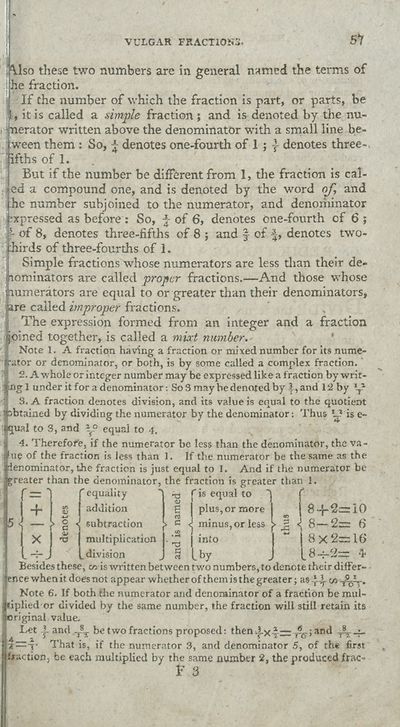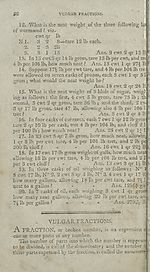Download files
Complete book:
Individual page:
Thumbnail gallery: Grid view | List view

VULGAR FRACTIONS.
SI
Also these two numbers are in general named the terms of
he fraction.
; If the number of which the fraction is part, or parts, be
i, it is called a simple fraction ; and is denoted by the nu-
s'i nerator written above the denominator with a small line be-
ween them : So, \ denotes one-fourth of 1 ; f denotes three-
iifthsofl.
But if the number be different from 1, the fraction is cal-
ed a compound one, and is denoted by the word of, and
he number subjoined to the numerator, and denoriiinator
; expressed as before : So, f of 6, denotes one-fourth of 6 ;
of 8, denotes three-fifths of 8 ; and of denotes two-
hirds of three-fourths of 1.
Simple fractions whose numerators are less than their de-
tominators are called proper fractions.—And those whose
tumerators are equal to or greater than their denominators,
ire called improper fractions.
The expression formed from an integer and a fraction
joined together, is called a mixt number.
Note 1. A fraction having a fraction or mixed number for its nume-
■ator or denominator, or both, is by some called a complex fraction.
2. A whole or integer number may be expressed like a fraction by writ-
ngl underitfor a denominator: So 3 may be denoted by i, and 12 by
3. A fraction denotes division, and its value is equal to the quotient
htained by dividing the numerator by the denominator: Thus 'A is e-
qual to 3, and equal to 4.
4. Therefore, if the numerator be less than the denominator, the va¬
ne of the fraction is less than 1. If the numerator be the same as the
lenominator, the fraction is just equal to 1. And if the numerator be
greater than the denominator, the fraction is greater than 1.
/'=') f equality r is equal to "l f
I + S I addition 1 | plus,or more j ^ j 8+ 2=: 10
5 s — r e <! subtraction r e > minus, or less (> j- ^ 8—2= 6
I X J •o ! multiplication j.| into I ~ | 8x2=16
[.division J § (.by J 8-4-2= b
Besides these, cn is written between two numbers, to denote their differ¬
ence when it does not appear whether of them is the greater; as
Note 6. If both the numerator and denominator of a fraction be mul-
tiplied or divided by the same number, the fraction will still retain its
original value.
Let i. and _8t be two fractions proposed: then and Ar-f-
i='Y That is, if the numerator 3, and denominator 5, of the first
fraction, be each multiplied by the same number 2, the produced frac-
F 3
SI
Also these two numbers are in general named the terms of
he fraction.
; If the number of which the fraction is part, or parts, be
i, it is called a simple fraction ; and is denoted by the nu-
s'i nerator written above the denominator with a small line be-
ween them : So, \ denotes one-fourth of 1 ; f denotes three-
iifthsofl.
But if the number be different from 1, the fraction is cal-
ed a compound one, and is denoted by the word of, and
he number subjoined to the numerator, and denoriiinator
; expressed as before : So, f of 6, denotes one-fourth of 6 ;
of 8, denotes three-fifths of 8 ; and of denotes two-
hirds of three-fourths of 1.
Simple fractions whose numerators are less than their de-
tominators are called proper fractions.—And those whose
tumerators are equal to or greater than their denominators,
ire called improper fractions.
The expression formed from an integer and a fraction
joined together, is called a mixt number.
Note 1. A fraction having a fraction or mixed number for its nume-
■ator or denominator, or both, is by some called a complex fraction.
2. A whole or integer number may be expressed like a fraction by writ-
ngl underitfor a denominator: So 3 may be denoted by i, and 12 by
3. A fraction denotes division, and its value is equal to the quotient
htained by dividing the numerator by the denominator: Thus 'A is e-
qual to 3, and equal to 4.
4. Therefore, if the numerator be less than the denominator, the va¬
ne of the fraction is less than 1. If the numerator be the same as the
lenominator, the fraction is just equal to 1. And if the numerator be
greater than the denominator, the fraction is greater than 1.
/'=') f equality r is equal to "l f
I + S I addition 1 | plus,or more j ^ j 8+ 2=: 10
5 s — r e <! subtraction r e > minus, or less (> j- ^ 8—2= 6
I X J •o ! multiplication j.| into I ~ | 8x2=16
[.division J § (.by J 8-4-2= b
Besides these, cn is written between two numbers, to denote their differ¬
ence when it does not appear whether of them is the greater; as
Note 6. If both the numerator and denominator of a fraction be mul-
tiplied or divided by the same number, the fraction will still retain its
original value.
Let i. and _8t be two fractions proposed: then and Ar-f-
i='Y That is, if the numerator 3, and denominator 5, of the first
fraction, be each multiplied by the same number 2, the produced frac-
F 3
Set display mode to:
![]() Universal Viewer |
Universal Viewer | ![]() Mirador |
Large image | Transcription
Mirador |
Large image | Transcription
| Antiquarian books of Scotland > Education > Complete treatise on practical arithmetic and book-keeping > (71) |
|---|
| Permanent URL | https://digital.nls.uk/114434422 |
|---|
| Description | Thousands of printed books from the Antiquarian Books of Scotland collection which dates from 1641 to the 1980s. The collection consists of 14,800 books which were published in Scotland or have a Scottish connection, e.g. through the author, printer or owner. Subjects covered include sport, education, diseases, adventure, occupations, Jacobites, politics and religion. Among the 29 languages represented are English, Gaelic, Italian, French, Russian and Swedish. |
|---|

